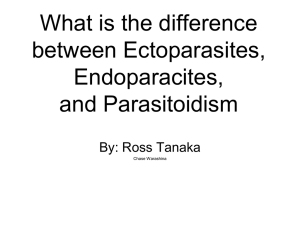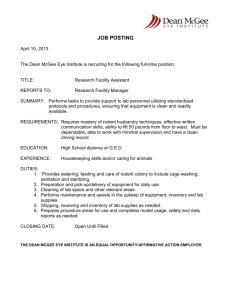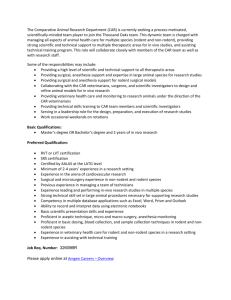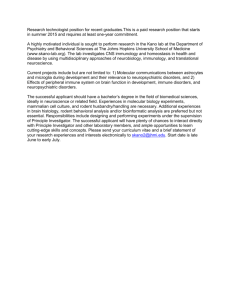Studies on Certain Ectoparasites Associated with Some Farm
advertisement
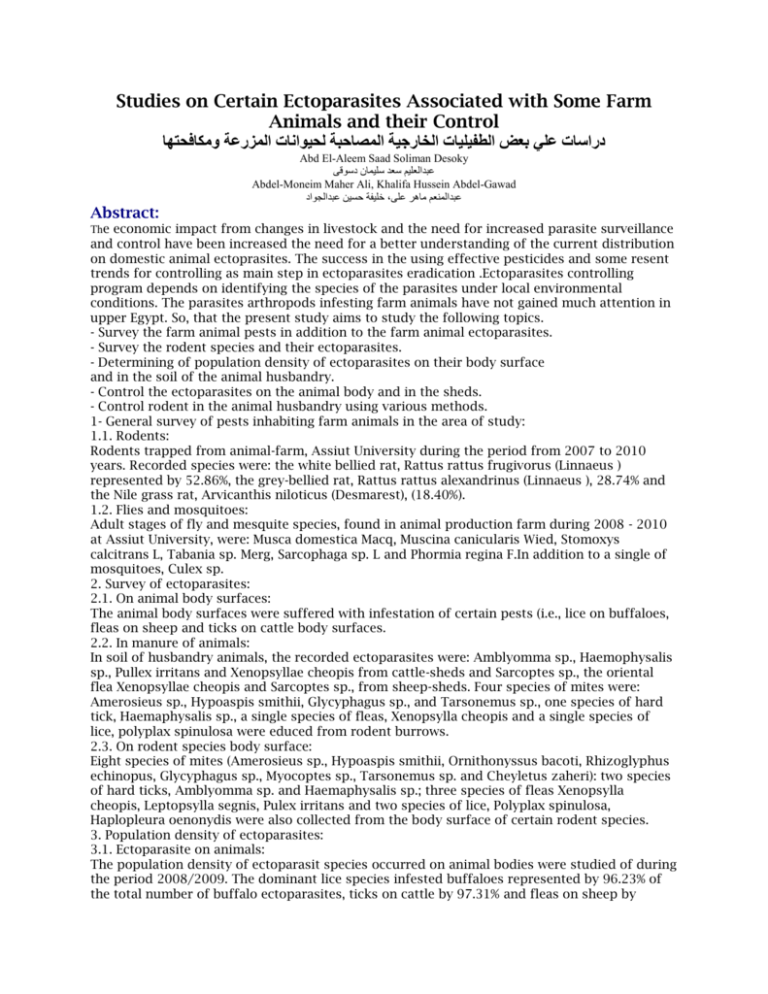
Studies on Certain Ectoparasites Associated with Some Farm Animals and their Control دراسات علي بعض الطفيليات الخارجية المصاحبة لحيوانات المزرعة ومكافحتها Abd El-Aleem Saad Soliman Desoky عبدالعليم سعد سليمان دسوقى Abdel-Moneim Maher Ali, Khalifa Hussein Abdel-Gawad خليفة حسين عبدالجواد،عبدالمنعم ماهر على Abstract: The economic impact from changes in livestock and the need for increased parasite surveillance and control have been increased the need for a better understanding of the current distribution on domestic animal ectoprasites. The success in the using effective pesticides and some resent trends for controlling as main step in ectoparasites eradication .Ectoparasites controlling program depends on identifying the species of the parasites under local environmental conditions. The parasites arthropods infesting farm animals have not gained much attention in upper Egypt. So, that the present study aims to study the following topics. - Survey the farm animal pests in addition to the farm animal ectoparasites. - Survey the rodent species and their ectoparasites. - Determining of population density of ectoparasites on their body surface and in the soil of the animal husbandry. - Control the ectoparasites on the animal body and in the sheds. - Control rodent in the animal husbandry using various methods. 1- General survey of pests inhabiting farm animals in the area of study: 1.1. Rodents: Rodents trapped from animal-farm, Assiut University during the period from 2007 to 2010 years. Recorded species were: the white bellied rat, Rattus rattus frugivorus (Linnaeus ) represented by 52.86%, the grey-bellied rat, Rattus rattus alexandrinus (Linnaeus ), 28.74% and the Nile grass rat, Arvicanthis niloticus (Desmarest), (18.40%). 1.2. Flies and mosquitoes: Adult stages of fly and mesquite species, found in animal production farm during 2008 - 2010 at Assiut University, were: Musca domestica Macq, Muscina canicularis Wied, Stomoxys calcitrans L, Tabania sp. Merg, Sarcophaga sp. L and Phormia regina F.In addition to a single of mosquitoes, Culex sp. 2. Survey of ectoparasites: 2.1. On animal body surfaces: The animal body surfaces were suffered with infestation of certain pests (i.e., lice on buffaloes, fleas on sheep and ticks on cattle body surfaces. 2.2. In manure of animals: In soil of husbandry animals, the recorded ectoparasites were: Amblyomma sp., Haemophysalis sp., Pullex irritans and Xenopsyllae cheopis from cattle-sheds and Sarcoptes sp., the oriental flea Xenopsyllae cheopis and Sarcoptes sp., from sheep-sheds. Four species of mites were: Amerosieus sp., Hypoaspis smithii, Glycyphagus sp., and Tarsonemus sp., one species of hard tick, Haemaphysalis sp., a single species of fleas, Xenopsylla cheopis and a single species of lice, polyplax spinulosa were educed from rodent burrows. 2.3. On rodent species body surface: Eight species of mites (Amerosieus sp., Hypoaspis smithii, Ornithonyssus bacoti, Rhizoglyphus echinopus, Glycyphagus sp., Myocoptes sp., Tarsonemus sp. and Cheyletus zaheri): two species of hard ticks, Amblyomma sp. and Haemaphysalis sp.; three species of fleas Xenopsylla cheopis, Leptopsylla segnis, Pulex irritans and two species of lice, Polyplax spinulosa, Haplopleura oenonydis were also collected from the body surface of certain rodent species. 3. Population density of ectoparasites: 3.1. Ectoparasite on animals: The population density of ectoparasit species occurred on animal bodies were studied of during the period 2008/2009. The dominant lice species infested buffaloes represented by 96.23% of the total number of buffalo ectoparasites, ticks on cattle by 97.31% and fleas on sheep by 78.47% of the parasites population .The highest density of ectoparasites in buffalo was recorded in spring (50.66%), and the lowest one was occurred in winter (3.39%). On cattle body surface, the highest density of ectoparasites was observed in spring (66.37%), the lowest population was recorded during winter representing by 2.69%. In sheep-farm, the highest density was observed in winter (67.83%) and the lowest was recorded during summer (5.19%). In 2009/2010, the lice were the dominant ectoparasites on buffaloes representing by 95.80% while ticks were the dominant ectoparsites on cattle representing by 94.81% and fleas on sheep represented by 94.32%. The highest density of ectoparasites in buffalo-farm was observed in spring (58.12%), the lowest population was recorded during winter (4.12%), whereas on cattle high population was recorded during spring (60.99%) and the lowest population was recorded in winter (5.19%), whereas on sheep winter harbored high density (76.56%), in contrary summer exhibited only (1.68%) of ectoparasites. Significant correlation coefficients between minimum and mean diurnal temperatures versus lice densities on buffaloes were 0.48* and 0.59*. (0.36* and 0.26*) were recorded between both temperatures versus ticks population on cattle. The effect of maximum and minimum relative humidity was also recorded (0.60*and 0.64*) on sheep fleas, significant correlation were obsereved during 2008/2009. In 2009/2010, r=0.48*was recorded between diurnal temp., of the density of lice on buffaloes, significant negative correlation (-0.71**and -0.69*) were found between max., and min., R.H. and the ticks population on cattle, (0.70and 0.65*) were recorded between max., and min., R.H. and fleas population sheep the study clearly indicated the temperature and relative humidity were determining factors in all husbandry animals ectoparasites and may explain the seasonal dynamics of these pests as well as the inhibition off- season. 3.2. Ectoparasites collected from animal manure: The population of ectoparasite species in the animal soil during 2008/2009 showed that, ticks dominant species of parasites in cattle-sheds represented by 61.54% , while in sheep-sheds the fleas represented by 98.44% of the parasites population .In rodent active burrows, the mites were represented by 92.09%. High density of ectoparasites in cattle farm was observed in spring 42.31%, scarce in autumn. In sheep-sheds 74.98 % of ectoparasites were collected in winter. The lowest population was recorded during summer 3.54%. In rodent burrows the highest population was observed during spring 35.60 %, the lowest on was recorded during summer 13.63%. In 2009/2010, the highest population of ticks in cattle-sheds was 70.27% of the total parasites population. While in sheep-sheds, the fleas represented by 98.11% of the total parasites population and 89.97% in rodent active burrows. The highest density of ectoparasites in cattle-sheds was observed in autumn (35.14%), the lowest was recorded during winter (14.41%). In sheep-sheds, the highest population was observed in winter (64.79%), the lowest one was recorded during summer (6.48 %). In rodent burrows, the highest population was observed in autumn (35.45%), the lowest population was recorded during summer (17.39 %). The maximum and minimum relative humidity were significant positive correlations (0.65*and 0.65*) were recorded between max, and min., R.H. versus animal manure ectoparasites, significant negative correlations were recorded (-0.68*and -0.62*) between max., and min., R.H. versus fleas in rodent burrows. 3.3. Ectoparasites on rodents: 3.3.1- Ectoparasites collected from Rattus r. frugivorus body surface: In 2007-2009, the study of rodent ectoparasites density showed that the high density of ectoparasites on Rattus r. frugivorus was observed in autumn (34.08%) followed by spring (27.99%) and summer (22.31%). The lowest population was recorded during winter (15.62%). Males rodent were found to be harbored the highest density of ectoparasites in March and the lowest was in January. In female rodents, the highest density was recorded in October and the lowest was noticed in January. In 2009- 2010, high density of ectoparasites was observed in autumn (34.99%) followed by spring (30.20%) and winter (22.91%). The lowest population was recorded during summer (11.90%). Males rodent were found to be harbored the highest density of ectoparasites in February and the lowest density in August, while in females rodents, the highest density of ectoparasites was recorded in October and the lowest was noticed in June. The comparative study between males and females showed that, there was an increase in the rate of infestation by females than males. Significant correlation coefficients (0.43* and 0.59**) were noticed between the maximum and minimum of relative humidity versus mites on males. Also significant positive correlation were recorded between mites on females and the maximum temperature, the maximum and minimum relative humidity r= (0.034*, 0.46* and 0.42*) during the first year, respectively. The same results were obtained during the second year of study. 3.3.2. Ectoparasites collected from Rattus r. alexandrines body surface: High density of ectoparasites was recorded during spring season followed by summer and autumn representing by 40.96%, 27.39% and 22.07%, respectively. The lowest density was observed during winter 9.58%. Male rodents were harbored the highest density of ectoparasites in June while the lowest density was in September, 2007-2009. In the second year, high density of ectoparasites was recorded during spring season 45.63% followed by winter and summer representing by8.13% and 10.63% respectively. The lowest density was observed during winter representing 8.13%. Males rodent were harbuored the highest density of ectoparasites in April and October, the lowest one occurred in January. In females of rodent, the highest density was found in females of both rodent species. Positive correlations were noticed between maximum temperature, minimum temperature, mean diurnal temperature and mean night temperature versus mites on rodent males (0.41*, 0.39*, 0.47*and 0.49*) respectively. 3.3.3. Ectoparasites collected from Arvicanthis niloticus body surface: The highest density of ectoparasites was recorded during summer and spring (31.37%, 29.81%). The lowest density was observed during winter by 11.49%. Males rodent were found to be harbored the highest density of ectoparasites in April, November and the lowest one in February, while in females rodent the highest density was found in both rodent species in June and July and the lowest one in January of 2009/2010. Significant positive correlations were recorded between the maximum temperature, minimum temperature, mean diurnal temperature and mean night temperature versus mites on rodent males (0.45*, 0.39*, 0.44*and 0.48*) respectively, and (0.51**, 0.61**, 0.56**and 0.58**) on rodent females respectively. 4. Control studies: 4.1. Control of ectoparasites in animal: 4.1.1. Ectoparasites on the animal body surface regions: Lice eggs were counted high numbers in animal front region,lice adult in medium region, nymph in back region. The population density of ticks on cattle in back region was higher than from front region. 4.1.2. In animals: The mean of mortality percentages of lice on buffaloes, tick on cattle and fleas on sheep were recorded after 45 days from treatment with Diazinon 15% EC spray at 1ml/liter water 32.13%, 26.16% and 12.43%, respectively. However, by using Diazinon 60% EC spray at 1ml/liter these percentages were 57.06%, 37.22% and 46.01%, for lice on buffaloes, tick on cattle and fleas on sheep. The percentages of reduction after 45 days from treatment when used Vertiemec 1.8% EC spray at 1ml/liter water were 56.03%,58.21% and 48.33% to lice on buffaloes, tick on cattle and fleas on sheep, but by using Butox 5% EC spray at 1ml/liter water these were 66.53%, 62.02% and 62.26%, respectively. The percentages of reduction after 45 days from treatment by using Ivermectin1%, 1m/50kg injection were 74.45%, 69.53% and 41.05% for the same animals of parasites, respectively. The mean mortality percentage to lice on buffaloes, tick on cattle, fleas on sheep after 45 days from treatment with Diazinon 60 % EC spray at 1.5 and 2ml/liter water, were recorded (59.19 and 59.11%, ) and (72.71 and71.40 ) respectively, also ( 68.71% and 64.26%, ) ,(83.26 and 76.49) with Vertimec 1.8% EC spray at 1.5 and 2ml/liter water, and ( 71.22% and 68.36%, ), (84.40 and 80.25) with Butox5% EC spray at 1.5 and 2ml/liter water. The mean mortality percentages to fleas on sheep after 30 days from treatment with Butox 5% EC spray at 1ml/liter water on sheep with and without wool were recorded (90.48 and 66.17%). The mean mortality percentage to lice on buffaloes, fleas on sheep were (39.99 and 13.46%), (59.72 and 34.91%) and (73.14 and56.12%) after 30 days from treatment with Radiant 12% SC spray at 4,6and 8 ml/liter water, respectively. But the percentage of reduction for tick on cattle was (33.23, 48.94 and 62.10 %,) after 30 days from treatment with Radiant 12% SC spray 6, 8 and12 ml/liter water, respectively. The mean mortality percentage to lice on buffaloes and ticks on cattle were 55.38 and 70.43% on lice and 40.63 and 62.03%, on ticks after 30 days from treatment with Diazinon 60% EC spraying and contact method at 1ml/liter water. 4.2. Control of sarcoptic mange: 4.2.1. In buffaloes: The results show that the treated individuals with sulfur began to respond after 45-55 days, 20-30days for Ivermectin 1% 1ml/50kg (injection) with sulfur, Ivermectin with Butox5% EC, 2530 days and Ivermectin 20-35. The spraying with Butox 5% EC and Ivermectin 1% injection gave satisfactory results in curing buffaloes mange. In general, all husbandry animals showed a slight improvement in the clinical picture of the disease by using Ivermectin one time a month, but gave satisfactory results when used at two time month (20- 30). It might be concluded that the subcutaneous injection with Ivermectin eliminates Sarcoptes scabiei from buffaloes after 20-30 days. 4.2.2. In sheep: Sarcoptes were sprayed with Diazinon 60% EC, Butox 5% EC and, Vertemic 1.8% EC spray at 1 ml/L water, Ivermectin 1% 1 ml/50kg (injection) and Ivermectin with Diazinon 60% EC, the results show that the treated individuals with Diazinon 60% EC began to respond after 25-30 days, 20-35 for Vertemic 1.8% EC, Butox5% EC 20-30 , and Ivermectin 15-30 days and Ivermectin with Diazinon 60% EC 15-25 days all sheep returned to normal conditions (normal skin ) after an average of 30-45. The spraying with Diazinon 60% EC, Butox 5% EC and Ivermectin injection gave satisfactory results in curing sheep mange. The results show that the treated individuals with tincture iodine 4% began to respond after 45-55 days; 35-45 days for sulfur with vaseline 10%, Ivermectin with sulfur 15-25 days and Ivermectin with Butox 5% EC 15-25, the spraying with Butox 5% EC and Ivermectin injection gave good results in curing buffalo mange. It might be concluded that Ivermectin with sulfur or Butox 5% EC are effective in controlling mange mites in husbandry animals. Morever, Injection treatment twice a month is better than a one-time use. 4.3. Control of manure ectoparasites: 4.3.1. Mechanical control: The mean mortality percentage to fleas on sheep in soil were recorded 80.27, 60.15 and 83.15%, after 45 days from treatment with mechanical methods, Cleaning, Burning, and Quicklime methods, respectively. 4.3.2. Chemical control: The mean mortality percentage to fleas on sheep in soil were recorded (86.53, 86.81 and 91.17% ), after 45 days from treatment with Diazinon 60% EC, Vertimec 1.8% EC, and Butox 5% EC spray at 2 ml/liter water, respectively. 4.3.3. Fly larvae: The mean of mortality percentage to fly larvae in animal manure, were recorded (91.51 and 95.27%, 84.25, 94.37 and 91.82), after 30 days from treatment with Diazinon 60% EC, Vertimec 1.8% EC and Butox 5% EC ( 1ml/liter ), Radiant 12% SC (4ml/L) and quicklime, respectively. The animal farm satisfactory, ventilation with periodical removal of animal manure and the renewal with the straw substrates, and the use of safer on the husbandry soil are recommended in order to control the immature stages of certain animal-ectoparasites such as flies and ticks. 5. Rodent control 5.1. Under laboratory conditions 5.1.1. Attractive baits: The mean consumption of attractive baits was recorded. Yeast with crush maize (7.25 gm/rat) and coriander (2.35 gm/rat) are the most effective baits as compare with control treatment of (crush maize) only (0.9 gm/rat), for R.r.frugivorus. But in R.r.alexandrinus, it was observed that the mean consumption was high in yeast bait with crush maize (7.35 gm/rat), and anise (3.63 gm) as compare with control (2gm/rat).In Arvicanthis niloticus the mean consumption was high in yeast bait (4.75 gm) as compared with the control bait (1.83gm/rat). Baits preference tests should be done periodically to find out the proper bait for rodenticide formulation and to overcome the shyness of rodent baits. 5.1.2. Repellent baits: The food consumption was less in black pepper bait with crush maize (0.32.5 gm/rat), jejoba seed (1.15 gm) as compared with control one (10.83gm/rat) for R.r.frugivorus. In R.r.alexandrinus was observed that the consumption was less in black pepper bait (0.38 gm/rat), and oshar powder leaf (0.85 gm/rat) as compared with control (7.05gm/rat). A. niloticus consumed scarce amount of black pepper bait (0.83 gm/rat) and powder leaf oshar (1.58 gm/rat) as compared with control (7.9gm/rat) .Generally; these results may be satisfied in rodent control. 5.1.3. Evaluation of two rodenticides: It was observed that the forced feeding of rodent males on Supercaid bait was (56.40 gm) as comparison with Caid (89 gm), but in females the numbers were: (61.80gm, 78.20gm) in the feeding on Supercaid and Caid tell death. In R.r. alexandrines, the males consumed less in Supercaid bait (43.40 gm) as comparison with Caid (80.40 gm),while the revere was observer in case females (34.60 gm, 74.80. gm), the same results were obtained when used A. niloticus. 5. 2. Under field conditions 5.2.1. Toxicity of rodenticides: Data show the mean of caught rodent individuals in field with baits satiations. Caid 0.005% was (8.18%) as compared by Supercaid 0.004% (2.18%). It was found that there was a significant difference between the caught animals of the tested rodenticide baits. 5.2.2. Acceptability of rodent species to two attractive baits: Data showed a significant difference in the animal consumptions of the rodenticide with different tested attractive baits. The consumption of attractive baits was 18.17 gm/day yeast with Supercaid as compared to vanilia with Supercaid, 11 gm/day. 5.2.3. Toxicity by aluminum phosphide 33%: The active burrows of rodent were decreased when used Aluminum phosphate fumigation (64.19%) after one month as compared to the normal burrows
